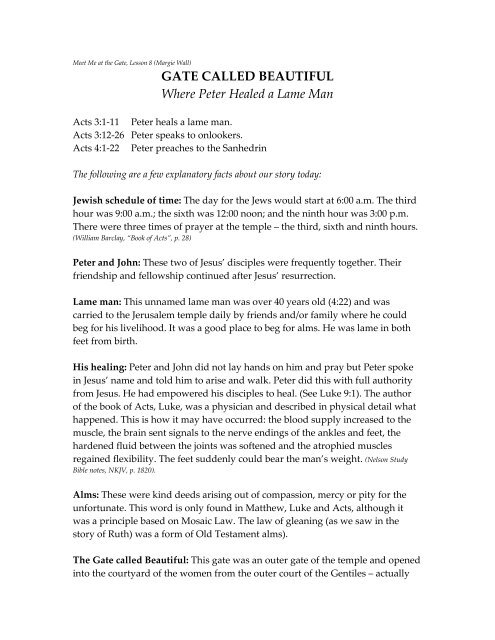GATE CALLED BEAUTIFUL Where Peter Healed a Lame Man
GATE CALLED BEAUTIFUL Where Peter Healed a Lame Man
GATE CALLED BEAUTIFUL Where Peter Healed a Lame Man
Create successful ePaper yourself
Turn your PDF publications into a flip-book with our unique Google optimized e-Paper software.
Meet Me at the Gate, Lesson 8 (Margie Wall)<br />
<strong>GATE</strong> <strong>CALLED</strong> <strong>BEAUTIFUL</strong><br />
<strong>Where</strong> <strong>Peter</strong> <strong>Healed</strong> a <strong>Lame</strong> <strong>Man</strong><br />
Acts 3:1-11 <strong>Peter</strong> heals a lame man.<br />
Acts 3:12-26 <strong>Peter</strong> speaks to onlookers.<br />
Acts 4:1-22 <strong>Peter</strong> preaches to the Sanhedrin<br />
The following are a few explanatory facts about our story today:<br />
Jewish schedule of time: The day for the Jews would start at 6:00 a.m. The third<br />
hour was 9:00 a.m.; the sixth was 12:00 noon; and the ninth hour was 3:00 p.m.<br />
There were three times of prayer at the temple – the third, sixth and ninth hours.<br />
(William Barclay, “Book of Acts”, p. 28)<br />
<strong>Peter</strong> and John: These two of Jesus’ disciples were frequently together. Their<br />
friendship and fellowship continued after Jesus’ resurrection.<br />
<strong>Lame</strong> man: This unnamed lame man was over 40 years old (4:22) and was<br />
carried to the Jerusalem temple daily by friends and/or family where he could<br />
beg for his livelihood. It was a good place to beg for alms. He was lame in both<br />
feet from birth.<br />
His healing: <strong>Peter</strong> and John did not lay hands on him and pray but <strong>Peter</strong> spoke<br />
in Jesus’ name and told him to arise and walk. <strong>Peter</strong> did this with full authority<br />
from Jesus. He had empowered his disciples to heal. (See Luke 9:1). The author<br />
of the book of Acts, Luke, was a physician and described in physical detail what<br />
happened. This is how it may have occurred: the blood supply increased to the<br />
muscle, the brain sent signals to the nerve endings of the ankles and feet, the<br />
hardened fluid between the joints was softened and the atrophied muscles<br />
regained flexibility. The feet suddenly could bear the man’s weight. (Nelson Study<br />
Bible notes, NKJV, p. 1820).<br />
Alms: These were kind deeds arising out of compassion, mercy or pity for the<br />
unfortunate. This word is only found in Matthew, Luke and Acts, although it<br />
was a principle based on Mosaic Law. The law of gleaning (as we saw in the<br />
story of Ruth) was a form of Old Testament alms).<br />
The Gate called Beautiful: This gate was an outer gate of the temple and opened<br />
into the courtyard of the women from the outer court of the Gentiles – actually
the front door to the temple proper. It was the most costly of all the temple gates<br />
and was made of Corinthian brass. It required 20 men to close it! (Lockyear’s All the<br />
Miracles of the Bible, p. 261).<br />
The temple: This is the third temple. The first temple was built by Solomon, the<br />
second by Zerubbabel and the Jews who returned from the Babylonian exile. The<br />
third (in the times of Jesus) was rebuilt by Herod the Great. All three stood on<br />
Mount Moriah (where Abraham went to sacrifice Isaac as a foretelling of Jesus’<br />
death). Solomon’s Temple was destroyed by the Babylonians in 587 BC.<br />
Zerubbabel rebuilt the temple in 515 BC. In 63 BC Roman General Pompey<br />
captured Jerusalem and took the temple. He did not destroy it, but Roman<br />
Consul Crassus plundered it of all gold later. Herod the Great in order to gain<br />
favor with the Jewish religious leaders had it restored and expanded, finishing it<br />
in AD 64. This temple was burned in 70 AD when Jerusalem fell to the Roman<br />
armies. The fourth temple prophesied by Ezekiel is yet in the future. (Zondervan’s<br />
Pictorial Bible Dictionary, pp. 830-836).<br />
<strong>Peter</strong>’s sermon to the Sanhedrin: Time fails us to go into this powerful sermon<br />
in detail. Remember, <strong>Peter</strong> who in fear denied the Lord three times before His<br />
death, now boldly confronts the whole Sanhedrin and charges them with the<br />
murder of the Messiah! (Lockyear’s “All the Miracles of the Bible” p. 262)<br />
The Sanhedrin: The Sanhedrin was made up of 70 men and the high priest. It<br />
was the highest Jewish court. The group consisted of the wealthiest, most<br />
educated, most powerful Jewish men in Israel. (Nelson Study Bible NKJV, pl. 1821).<br />
Conclusion: The Jewish temple was one of segregation. Gentiles could only be in<br />
the large outer courtyard. Jewish women could go into a special outer vestibule<br />
of the temple proper. Only Jewish men and priests could go into the inner temple<br />
and only the priests into their courts and the Holy Place. The Most Holy Place<br />
was only entered by the high priest, once a year.<br />
When Jesus died, the veil in the temple was rent in two, symbolizing that<br />
we no longer needed a high priest to enter the Most Holy Place. Through His<br />
death and resurrection, we can all access the throne of God! Read this in<br />
Matthew 27:50-51 and Hebrews 10:19-22.<br />
Imagine the situation of this man – lame for 40 years. He asks <strong>Peter</strong> for money and then<br />
pays attention, gets helped up by <strong>Peter</strong> and begins standing, then walking, then jumping<br />
and finally PRAISING GOD! What are some of the miracles in our lives that we can<br />
praise God for. How can that be a witness to those who see and hear us? Discuss.


